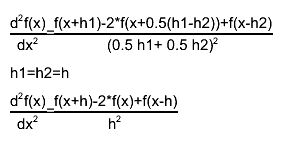
Function Members (Methods)
public:
Data Members
public:
| Float_t | B[3] | magnetic field |
| Float_t | BDTresh | hole multiplication - break down treshold |
| Int_t | BreakDown | if break down occurs it goes to 1 otherwise is 0 |
| TH3I* | KGeometry::DM | detector material |
| TH3I* | KGeometry::EG | electrode geometry |
| static Int_t | KMaterial::ImpactIonization | impact ionization model |
| Float_t | MTresh | treshold for taking multiplication into account |
| static Int_t | KMaterial::Mat | Material index |
| static Int_t | KMaterial::Mobility | mobility model for each material |
| TF3* | NeffF | effective dopping concentration function |
| TH3F* | NeffH | effective dopping concentration histogram |
| KField* | Ramo | ramo field |
| KField* | Real | electric field |
| Float_t | SStep | Simulation step size; |
| static Float_t | KMaterial::Temperature | Temperature |
| Float_t | Voltage | Voltage |
| Float_t | Voltage2 | Voltage2 |
| TArrayF | Voltages | Array of voltages |
| Int_t | average | Average (over how many events) |
| Int_t | diff | Diffusion simulation (yes=1, no=0) |
| Float_t | enp[3] | entry point for the charge drift |
| Float_t | exp[3] | exit point for the cahrge drift |
| TH1F* | neg | contribution of the electrons to the total drift current |
| Int_t | KGeometry::nx | x-divisions |
| Int_t | KGeometry::ny | y-divisions |
| Int_t | KGeometry::nz | z-divisions |
| TH1F* | pos | contribution of the holes to the total drift current |
| TH1F* | sum | total drift current |
| Float_t | taue | effective trapping time constants - used if Multiplication is ON |
| Float_t | tauh | effective trapping time constants - used if Multiplication is ON |
Class Charts
| Inheritance Chart: | ||||||||||||||||||||||||
|
Function documentation
double V(int , int )
Double_t kappa(int , int , int , int )
Sets the effective space charge values for given point in the mesh!
TH2F * Draw(Char_t* , Float_t = 1)
The function draws weighting and electric field and also the event display Float_t proj; position along the axis of projection Char_t *option: Which field do you want to plot? W -weighting E -electric G -geometry M -material N -Neff = space charge What do do want to plot? P - potential F - |field| X - x component of the field Y - y component of the field Z - z component of the field In case of 3D which plane? yz - the cross section is along the x value of proj xz - the cross section is along the y value of proj xy - the cross section is along the z value of proj
void ShowMipIR(Int_t , Int_t = 14, Int_t = 1)
The simulation of the drift for the minimum ionizing particles. A track is devided into Int_ div buckets. Each bucket is drifted in the field. The induced currents for each carrier is calculated as the sum all buckets.
KDetector()
Author: Gregor Kramberger Default constructor for KDetector class Default = no space charge -> default space charge is function
void SetDriftHisto(Float_t x, Int_t = 200)
void ShowGaussBeam(Int_t , Float_t , Float_t , Float_t , Int_t , Int_t )
Gaussian Beam for strip detector A track is divided into Int_ div buckets. Each bucket is drifted in the field. The induced currents for each carrier is calculated as the sum all buckets. - Lambda [um] - w0 [um]
void SetVoltage(Float_t x, Int_t calnow = 1)
Calculation in case of any changes
{Voltage=x; if(calnow) CalPhyField(); }